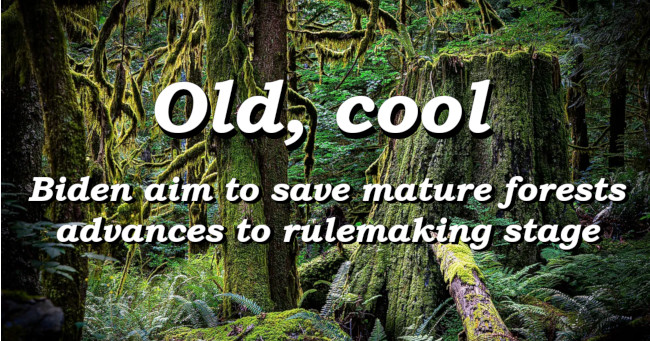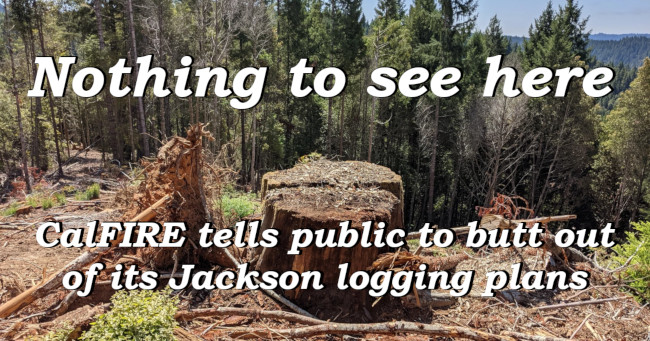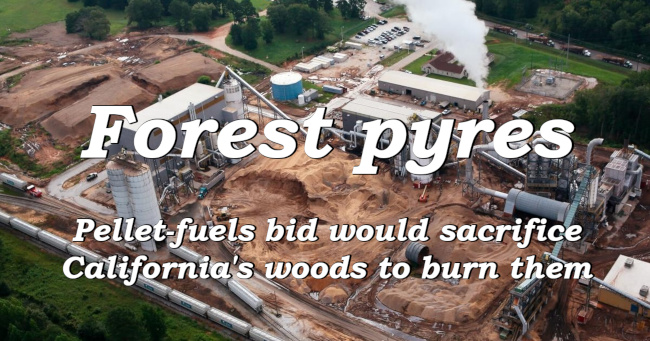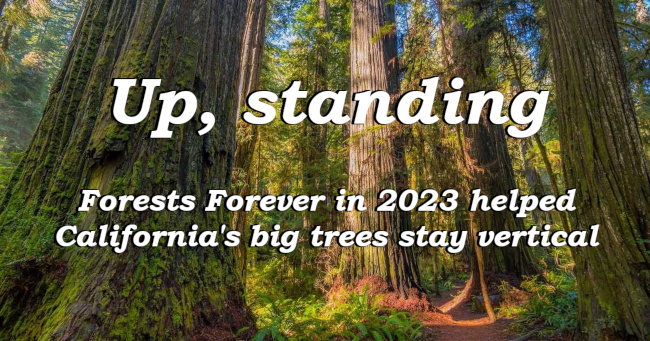| Donate |
Forest-protection struggles occur at every jurisdictional level in California—on land ownerships federal, state, county, and private. And as we have in the past Forests Forever in 2023 made its mark in pretty much all of them.
After an Earth Day 2022 Biden administration proclamation stating the White House's intention to safeguard old-growth, advocates including Forests Forever exerted pressure that year and in '23 to get us to a very-recent announcement: National forest plan amendments to save ancient forests will be crafted with broad public input.
At the state level we generated emails, calls and letters helping to call out CalFIRE's dodgy maneuver to try to skip its customary environmental and public-transparency reporting as the agency seeks to package its new-and-improved logging plans at Jackson Forest in a pretty green wrapper.
We assisted in a local battle, in an area where we had worked as early as 2016, to turn away a forest-destroying Napa County vineyard proposal, Le Colline, that was flashing fake eco-credentials.
And as the year came to a close we shone a light on an emerging new threat at the state level—a plan to strip forests across tens of thousands of square miles to feed highly polluting pellet-manufacturing plants.
At every step of the way Forests Forever supporters like you helped with their actions ranging from clicks on our social media posts to emails to calls and letters, and to funding.
Please donate today to keep our work going into 2024 and beyond.
Mature and old-growth forest conservation—federal policy
By early 2023 recent events had pushed the urgency of saving forests worldwide to new heights.
The COP 27 climate conference in November 2022, election results in the U.S. and Brazil, and a flood of new climate catastrophes were among developments that made it clearer than ever before that forest conservation—especially saving older, mature forests—must be a starting point in any strategy to reverse environmental catastrophe.
On Earth Day 2022 President Joe Biden, commendably, had issued Executive Order (E.O.) 14072 committing the U.S. government to develop policies to save mature and older forests. 
At that point, in the continental U.S. about 50 million acres of older federal forests were under threat of destruction and degradation by logging. If cut down in the next 10 years these forests alone would release enough climate-heating gases to equal nine percent of total U.S. emissions annually.
"Protecting older forests from logging on federal lands is critical to President Biden's plan to reduce greenhouse gas emissions by 50 to 52 percent of 2005 levels by 2030," said Dr. Dominick A. DellaSala, a leading forest scientist.
Although praiseworthy—especially with Congress hamstrung in its ability to act swiftly and decisively—the E.O. needed major strengthening to take into scope all significant threats to the forest biome above and beyond logging. This included global warming, off-road vehicle use, fossil fuel extraction projects, grazing, fragmentation from roadbuilding, and more.
Forests Forever was among the Forest Carbon Coalition groups that signed a letter calling on senior Biden Administration officials to take stronger action for mature forests. Saving mature and old-growth forests would help to achieve both the federal and state goals of saving 30 percent of lands and waters as functioning natural habitat by 2030. 
Healthy and abundant forests cleanse air and water, enrich wildlife habitat, and underpin strong and sustainable tourism and recreation economies.
In response to our call Forests Forever members contacted federal officials, calling on them to strengthen 14072 by placing a moratorium on degrading or destroying these invaluable ecosystems; by expanding protections to the somewhat-younger forests that will grow into the bigger trees of the future; and by curbing ranching and grazing, extraction of fossil fuels on forestlands, roadbuilding and fragmentation, and invasive species.
Contrary to the claims of the timber industry and its adherents, logging in most cases promotes wildfire by removing the least-flammable trees from the forest and by heating and drying the area left behind, setting the stage for combustion. Moreover, old-growth represents not just better habitat than most other forests, but also unique habitat, and today makes up just 13 percent of its historical range.
We were heard.
In spring of 2023 the land-management agencies with authority over most of the country's public forestlands—the U.S. Forest Service and federal Bureau of Land Management—opened up processes to take comments on proposed regulations to implement 14072.
 In garnering comments this time our emphasis was specifically on logging threats to forests, on the need to safeguard not just the oldest trees, but also the mature trees that will become old-growth down the line—trees as young as 80 years of age.
In garnering comments this time our emphasis was specifically on logging threats to forests, on the need to safeguard not just the oldest trees, but also the mature trees that will become old-growth down the line—trees as young as 80 years of age.
Our commenters underlined the fact that saved mature and old-growth forests are the most effective and cheapest way to remove carbon from the atmosphere and hold onto this carbon in great quantities.
By the end of the public comment period on July 20, 2023, more than 530,000 people nationwide had called on the Forest Service to safeguard mature and old-growth forests.
The latest: On Dec. 19 the U.S. Department of Agriculture, the Forest Service's parent agency, issued a Notice of Intent (NOI) for a National Forest Plan Amendment to Conserve and Steward Old Growth Forests nationwide. A public comment period on this step has begun and will end Feb. 2, 2024. Another comment period will follow next summer.
This will be the focus of much organizing in the months ahead. In addition, the NOI only covers old-growth forests, not mature forests. Stay tuned for a Forests Forever alert calling for comments to strengthen the forest plan amendment process; and we will continue to call for a national rule to protect mature forests.
| Donate |
Jackson Demonstration State Forest, Mendocino County
CalFIRE earlier this year announced that it intended to skip the customary environmental and public review process when the agency releases its promised Jackson Demonstration State Forest management plan.
This was a huge red flag with regard to CalFIRE's (the California Department of Forestry and Fire Protection's) intentions regarding transparency and resource protection on the 49,000-acre taxpayer-owned redwood forest in Mendocino County.
The agency has been industrially logging Jackson Forest for decades and presumably intends to continue to do so under a new management plan. Yet CalFIRE says it will not be issuing an Environmental Impact Report (EIR) covering the plan, despite the plan's anticipated embrace of logging. 
Recent studies have underscored the value of redwood forests, with their extremely tall trees and deep soils, as perhaps the best forests on Earth for sequestration of carbon.
CalFIRE already had stiff-armed the conservation community and its tribal allies in 2022 when, in the midst of negotiations with area tribes concerning cultural-resource protection and their access to Jackson, the agency announced it would resume logging on four parcels in the forest.
Back in 2002, in the course of conducting a broad-based grassroots campaign, Forests Forever and allies successfully sued CalFIRE over an inadequate Jackson management plan. We won and the suit helped to halt logging there for some eight years.
Logging in California is supposed to comply with the California Environmental Quality Act, which provides for public participation and environmental review of such activities, especially on public land. Simple dissemination of a Timber Harvesting Plan describing a given logging project is no equivalent to an EIR.
Recent years have brought heightened pressure to address demands for co-management of Jackson with Native Americans who have called the area home for thousands of years. In response to this outcry a series of promising pronouncements followed, from the governor and the California Natural Resources Agency on down.
The California Board of Forestry and Jackson's managers have officially stated their intention to rewrite the forest's management plan several years ahead of schedule, in large part to address these concerns. Here is CalFIRE's recently issued Request for Early Review of the Jackson Demonstration State Forest Management Plan.
Forests Forever in July called for letters to Gov. Gavin Newsom and other state officials, urging them to take swift and effective action to ensure that Jackson Forest's management plan includes an EIR, affording meaningful public input and environmental review.
Outlook from here: In 2024 Jackson will remain in the headlines, with community demands that no new logging plans go forward there until the new management plan is in place. The area's state senator, Mike McGuire, and Assemblymember, Jim Wood, have called for this commonsense step in light of the ongoing controversy.
Conservation groups and tribes will continue to point out that state law (Assembly Bill 52) requires CalFIRE to consult with tribes on any proposed activity that could harm their cultural resources.
And there will continue to be calls for a legislative change to Jackson's timber-intensive mission, such as the one Forests Forever sponsored in 2004 (Senate Bill 1648) when it passed both houses of the legislature before its veto by then-Gov. Arnold Schwarzenegger.
There can be no doubt: Intact redwood forests are much more valuable for carbon sequestration, water storage and purification, wildfire control, and recreation, than for sawlogs.
| Donate |
GSNR pellet-plant project, California
These days timber companies and other backers of the most-damaging industrial logging prefer to characterize their projects as "forest restoration" work or re-establishing "forest health" in the expectation that their activities will fly under the radar of the law and public scrutiny.
One especially onerous such scheme is a rapidly advancing "green energy" project put forward by Golden State Natural Resources (GSNR)—the so-called "Forest Resiliency Demonstration Project."
It would consist of building two new wood-pellet manufacturing plants in California—one in Lassen County and the other in Tuolumne County not far from Yosemite National Park. 
Each proposed plant marks the center of a circle 200 miles in diameter, within which "feedstock"—woody biomass including not just branches but also trees of any size or species— would be collected to stoke the plant.
From this 63,000-square-mile total area these plants would produce one million tons of pellets per year for export and burning in foreign power stations.
But burning woody biomass to generate electricity is neither clean nor sustainable. In fact, it generates more CO2 than coal, per unit of electricity produced.
Every stage in the wood-pellet manufacturing process is dirty and climate-damaging. To begin with, extracting woody biomass from the forest brings loss of habitat, soil damage, and water pollution, above and beyond removal of carbon-sequestering trees and other vegetation.
Next, processing this material into pellets emits heavy metals such as lead and mercury and carcinogens including dioxin.
The highly flammable pellets must be safely stored and handled. And the whole process generates wood-dust particles that are harmful to the lungs and can be explosive.
Under the heading of environmental justice concerns, the Port of Stockton area, where GSNR seeks to store and ship out its pellets, carries one of the highest pollution burdens in the state, along with high rates of asthma and cardiovascular disease and a high poverty rate. Hundreds of truckloads would rumble along local roadways to and from the plants each day. 
This threat to forests and to the human communities in the path of this industrial activity must be stopped before it gets going. If we allow these plants to be built they will require a supply of forest-sourced material for as long as they remain in operation.
This at a time when forests provide far-more-valuable services by every measure than generating electricity—from soaking up and storing atmospheric carbon; to collecting, purifying, and releasing clean water; to sheltering threatened biodiversity; to providing the basis for strong and sustainable tourism, retirement, and recreation economies.
Forests Forever is one of over 100 concerned organizations that signed a detailed comment letter opposing the project, which you can view here. We have called on state officials to halt GSNR's pellet-fuels scheme immediately.
What's next: In the coming months its backers will issue a Draft Environmental Impact Report (DEIR) for the project. Stay tuned for alerts from Forests Forever and its allies calling for DEIR comments in opposition.
But before then we are urging Gov. Gavin Newsom, Resources Secretary Wade Crowfoot, CalEPA Secretary Yana Garcia, and other key officials to stop the project in its tracks.
Le Colline vineyard victory, Napa County
By the summer of 2023 a high-profile deforestation project in Napa County had built up a head of steam.
Forests Forever joined with our Napa County watershed-protection allies to oppose the Le Colline vineyard project, touted by its Utah developer/backer as offering "net zero" loss of carbon sequestration.
This despite the fact that it would destroy nearly 30 acres of native forestland and threaten a major downstream water supply source (Lake Hennessey) of the City of Napa.
In addition to degrading the habitat of several rare species the Le Colline project would have marred the viewshed of adjacent Linda Falls Nature Preserve, with its hiking trails and impressive 50-foot waterfall.
Concerned citizens and conservation groups pointed out the potential threats to wildlife and water quality, as well as the deficient environmental report accompanying the project, which belied its green "net zero" billing.
 Forests Forever has worked intermittently since 2016 with our colleagues in Napa County, culminating in 2018's county-level Measure C. That fight prefigured the subsequent halting of sprawling development at Walt Ranch. We were primed, therefore, to help in generating comments and calling on the Napa County board of supervisors to uphold an appeal of the Le Colline project by the Center for Biological Diversity.
Forests Forever has worked intermittently since 2016 with our colleagues in Napa County, culminating in 2018's county-level Measure C. That fight prefigured the subsequent halting of sprawling development at Walt Ranch. We were primed, therefore, to help in generating comments and calling on the Napa County board of supervisors to uphold an appeal of the Le Colline project by the Center for Biological Diversity.
In a 3-2 vote on Aug. 15 the supes did just that, and on Nov. 7 followed it up with a final vote killing the project.
Looking ahead: We wish we could report that the Le Colline victory settled matters in Napa County, that watersheds there are now secure. Unfortunately that would be a stretch. The Measure C campaign, in which Forests Forever played a key role in voter outreach and education, was massively outspent by Big Ag and wine industry opposition including the Farm Bureau, grape growers, and ranchers.
In the wake of Le Colline these powerful interests are unlikely to give up anytime soon. As quoted in Wine Business in November, Napa County Winegrowers executive director Michelle Benvenuto told the supervisors, "Winegrowers is concerned with the prevalence of emotional appeals overshadowing evidence-based discourse in Napa County's public policy discussions on agriculture."
This despite the fact that the winning supervisors cited some 14 Napa County Plan conservation regulations informing their vote.
Laurie Claudon of Clark-Claudon Vineyards later wrote: "The 'phylloxera' of our time is climate change and decreasing natural resources." We couldn't agree more! In Napa County, as elsewhere, we must remain vigilant as future threats to forests, watersheds, and the quality of life emerge.

Paul Hughes
Executive Director
Forests Forever
| Your contribution today will help California's forests thrive! | |
|
